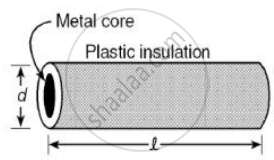Advertisements
Advertisements
प्रश्न
How will the resistance of a wire be affected if its
- length is doubled, and
- radius is also doubled ?
Give justification for your answer.
उत्तर
R `=(rho"l")/"A"`
Where, `rho` = electrical resistivity
l = length of the conductor
A = cross-sectional area of the conductor
Hence if the length is double then
⇒ `"R"_1=rho((2"l"))/"A"`
`therefore "R"_1 = 2("R")`
So, if the length of the resistance gets doubled then resistance also gets doubled.
Now when the radius is double then
⇒ `"R"_2 = (rho"l")/"A"`
⇒`"R"_2 = (rhol)/(pi(2"r")^2`
`therefore "R"_2 = 1/4("R")`
So if the radius gets doubled then resistance will be `(1/4)^"th"` of initial resistance.
APPEARS IN
संबंधित प्रश्न
Why are copper and aluminium wires usually employed for electricity transmission?
What is the general name of the substances having infinitely high electrical resistance?
What happens to the resistance as the conductor is made thicker?
Which among iron and mercury is a better conductor of electricity?
What do you understand by the "resistivity" of a substance?
What would be the effect on the resistance of a metal wire of:
increasing its diameter?
Resistance of a metal wire of length 5 m is 100 Ω . If the area of cross - section of the wire is `3 × 10^-7 "m"^2` , Calculate the resistivity of the metal .
How will you infer with the help of an experiment that the same current flows through every part of the circuit containing three resistors R1, R2 and R3 in series connected to a battery of V volts?
Assertion: Conductors allow the current to flow through themselves.
Reason: They have free charge carriers.

Plastic insulation surrounds a wire having diameter d and length l as shown above. A decrease in the resistance of the wire would be produced by an increase in the ______.
